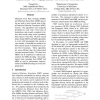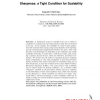1369 search results - page 25 / 274 » Lattice computations for random numbers |
DNA
2006
Springer
14 years 14 days ago
2006
Springer
Self-repair is essential to all living systems, providing the ability to remain functional in spite of gradual damage. In the context of self-assembly of self-repairing synthetic b...
SEMWEB
2010
Springer
13 years 6 months ago
2010
Springer
We present a scalable, SPARQL-based computational pipeline for testing the lattice-theoretic properties of partial orders represented as RDF triples. The use case for this work is ...
ACL
2009
13 years 6 months ago
2009
Minimum Error Rate Training (MERT) and Minimum Bayes-Risk (MBR) decoding are used in most current state-of-theart Statistical Machine Translation (SMT) systems. The algorithms wer...
SIROCCO
2008
13 years 10 months ago
2008
: A distributed system is scalable if the rate at which it completes its computation and communication tasks does not depend on its size. As an example, the scalability of a peer-t...
CRYPTO
2001
Springer
14 years 1 months ago
2001
Springer
Consider a network of processors among which elements in a finite field K can be verifiably shared in a constant number of rounds. Assume furthermore constant-round protocols ar...


